A. O. Smith GPVH-40 Installation Manual
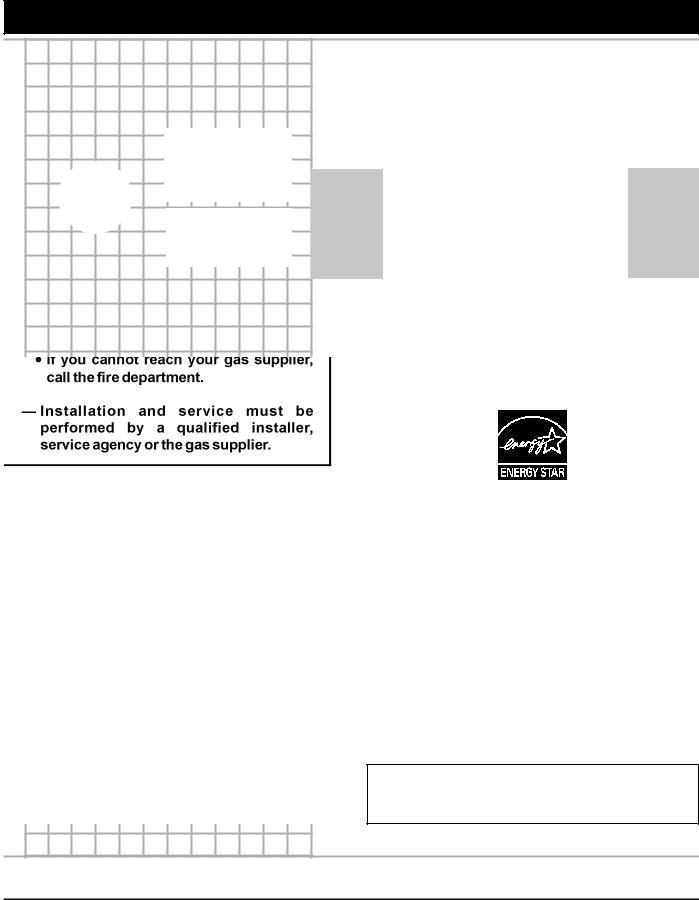
Instruction Manual
RESIDENTIAL GAS WATER HEATERS
POWER VENTED GAS MODELS WITH HOT SURFACE IGNITION
NOT FOR USE IN MANUFACTURED (MOBILE) HOMES
GAMA certification applies to all residential gas water heaters with capacities of 20 to 100 gallons with input rating of 75,000 BTU/Hr. or less.
• For Your Safety •
AN ODORANT IS ADDED TO THE GAS USED
BY THIS WATER HEATER.
ALL TECHNICAL AND WARRANTY QUESTIONS: SHOULD BE DIRECTED TO THE LOCAL DEALER FROM WHOM THE WATER HEATER WAS PURCHASED. IF YOU ARE UNSUCCESSFUL, PLEASE WRITE TO THE COMPANY LISTED ON THE RATING PLATE ON THE WATER HEATER.
KEEP THIS MANUAL IN THE POCKET ON HEATER FOR FUTURE REFERENCE
WHENEVER MAINTENANCE ADJUSTMENT OR SERVICE IS REQUIRED.
PRINTED 1208 |
1 |
315465-000 |
|
|
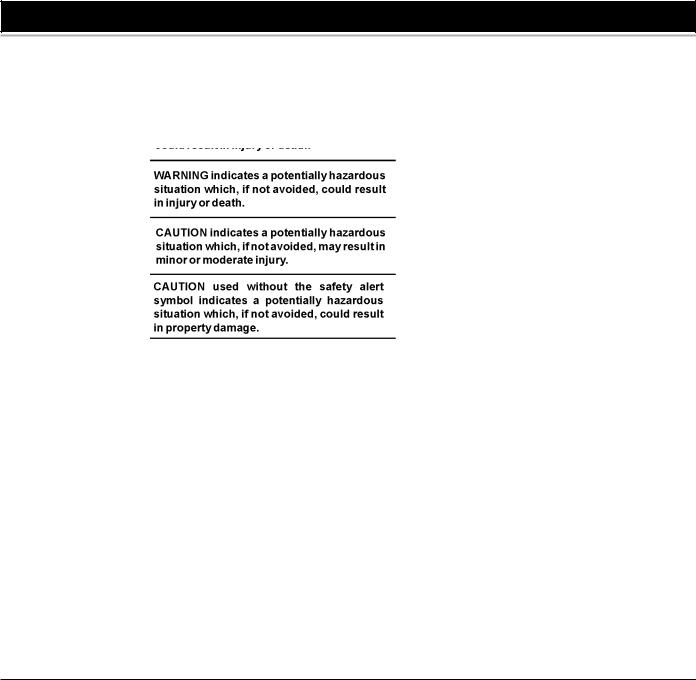
SAFE INSTALLATION, USE AND SERVICE
Your safety and the safety of others is extremely important in the installation, use and servicing of this water heater.
Many safety-related messages and instructions have been provided in this manual and on your own water heater to warn you and others of a potential injury hazard. Read and obey all safety messages and instructions throughout this manual. It is very important that the meaning of each safety message is understood by you and others who install, use or service this water heater.
All safety messages will generally tell you about the type of hazard, what can happen if you do not follow the safety message and how to avoid the risk of injury.
The California Safe Drinking Water and Toxic Enforcement Act requires the Governor of California to publish a list of substances known to the State of California to cause cancer, birth defects, or other reproductive harm, and requires businesses to warn of potential exposure to such substances.
WARNING: This product contains a chemical known to the State of California to cause cancer, birth defects, or other reproductive harm. This appliance can cause low-level exposure to some of the substances included in the Act.
IMPORTANT DEFINITIONS
•Qualified Installer: A qualified installer must have ability equivalent to a licensed tradesman in the fields of plumbing, air supply, venting and gas supply, including a thorough understanding of the requirements of the National Fuel Gas Code as it relates to the installation of gas fired water heaters. The qualified installer must also be familiar with the design features and use of flammable vapor ignition resistant water heaters, and have a thorough understanding of this instruction manual.
•Service Agency: A service agency also must have ability equivalent to a licensed tradesman in the fields of plumbing, air supply, venting and gas supply, including a thorough understanding of the requirements of the National Fuel Gas Code as it relates to the installation of gas fired water heaters. The service agency must also have a thorough understanding of this instruction manual, and be able to perform repairs strictly in accordance with the service guidelines provided by the manufacturer.
•Gas Supplier: The Natural Gas or Propane Utility or service who supplies gas for utilization by the gas burning appliances within this application. The gas supplier typically has responsibility for the inspection and code approval of gas piping up to and including the Natural Gas meter or Propane storage tank of a building. Many gas suppliers also offer service and inspection of appliances within the building.
2
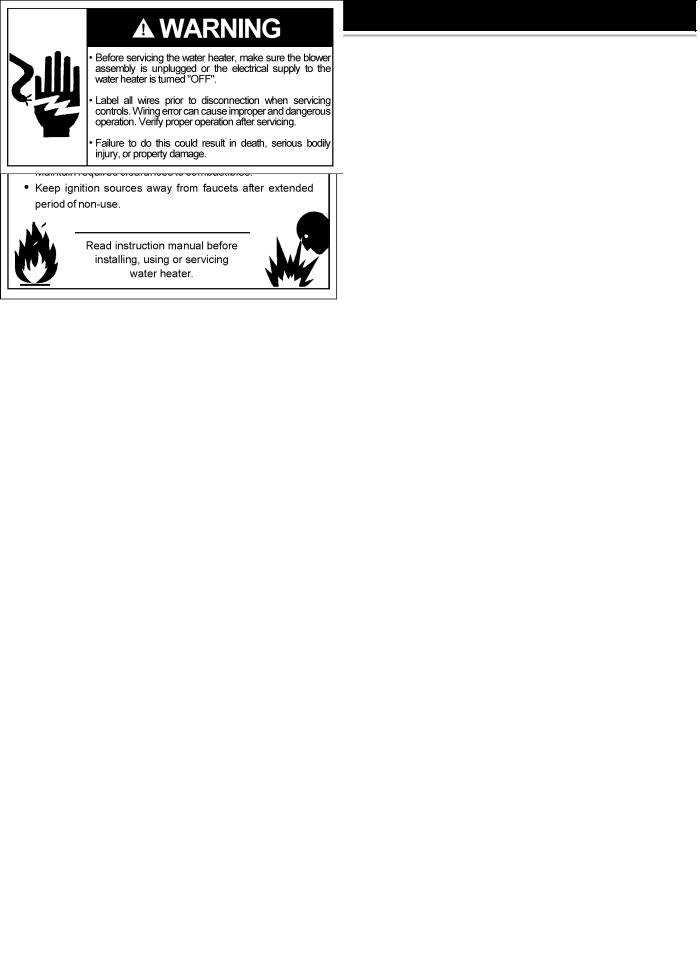
GENERAL SAFETY
3

TABLE OF CONTENTS
SAFE INSTALLATION, USE AND SERVICE............................ |
2 |
GENERAL SAFETY.................................................................. |
3 |
TABLE OF CONTENTS............................................................ |
4 |
INTRODUCTION...................................................................... |
4 |
Preparing for the New Installation..................................... |
4 |
INSTALLATION REQUIREMENTS FOR THE |
|
COMMONWEALTH OF MASSACHUSETTS ........................... |
5 |
TYPICAL INSTALLATION..................................................... |
6-7 |
LOCATING THE NEW WATER HEATER............................. |
8-9 |
Facts to Consider About Location................................. |
8-9 |
Insulation Blankets............................................................ |
9 |
Combustion Air and Ventilation for Appliances |
|
Located in Unconfined Spaces ......................................... |
9 |
Combustion Air and Ventilation for Appliances |
|
Located in Confined Spaces....................................... |
9-10 |
INSTALLING THE WATER HEATER................................ |
10-21 |
Water Piping .............................................................. |
11-12 |
Temperature-Pressure Relief Valve ................................ |
12 |
Gas Piping ...................................................................... |
13 |
Sediment Traps............................................................... |
14 |
Blower Assembly Installation .......................................... |
14 |
Vent Pipe Connection to Blower Assembly..................... |
15 |
Venting and Installation............................................. |
15-16 |
LIGHTING & OPERATING LABEL ......................................... |
21 |
TEMPERATURE REGULATION ............................................ |
22 |
FOR YOUR INFORMATION................................................... |
23 |
Start Up Conditions......................................................... |
23 |
Condensate..................................................................... |
23 |
Smoke/Odor.................................................................... |
23 |
Thermal Expansion......................................................... |
23 |
Strange Sounds .............................................................. |
23 |
Operational Conditions ................................................... |
23 |
Smelly Water................................................................... |
23 |
“Air” in Hot Water Faucets .............................................. |
23 |
High Temperature Shut Off System ................................ |
23 |
PERIODIC MAINTENANCE................................................... |
24 |
Venting System Inspection.............................................. |
24 |
Burner Inspection............................................................ |
24 |
Burner Cleaning.............................................................. |
24 |
Housekeeping........................................................... |
24-25 |
Anode Rod Inspection..................................................... |
25 |
Temperature-Pressure Relief Valve Operation ............... |
25 |
Draining........................................................................... |
25 |
Drain Valve Washer Replacement ............................ |
25-26 |
Service............................................................................ |
26 |
LEAKAGE CHECKPOINTS.................................................... |
26 |
REPAIR PARTS...................................................................... |
27 |
TROUBLESHOOTING ..................................................... |
28-30 |
WARRANTY ........................................................................... |
31 |
INTRODUCTION
Thank You for purchasing this water heater. Properly installed and maintained, it should give you years of trouble free service.
Abbreviations Found In This Instruction Manual:
•CSA - Canadian Standards Association
•ANSI - American National Standards Institute
•NFPA - National Fire Protection Association
•ASME - American Society of Mechanical Engineers
•GAMA - Gas Appliance Manufacturer’s Association
•UL - Underwriters Laboratories Inc.
This gas-fired water heater is design certified by Underwriters Laboratories
Inc. under American National Standard/CSA Standard for Gas Water Heaters ANSI Z21.10.1 • CSA 4.1 (current edition).
PREPARING FOR THE INSTALLATION
1. Read the “General Safety” section, page 3 of this manual first and then the entire manual carefully. If you don’t follow the safety rules, the water heater will not operate properly. It could cause DEATH,
SERIOUS BODILY INJURY AND/OR PROPERTY DAMAGE.
This manual contains instructions for the installation, operation, and maintenance of the gas-fired water heater. It also contains warnings throughout the manual that you must read and be aware of. All warnings and all instructions are essential to the proper operation of the water heater and your safety. Since we cannot put everything on the first few pages, READ THE ENTIRE MANUAL
BEFORE ATTEMPTING TO INSTALL OR OPERATE THE WATER
HEATER.
4
2.The installation must conform with these instructions and the local code authority having jurisdiction. In the absence of local codes, installations shall comply with the National Fuel Gas Code ANSI Z223.1/NFPA
54 and the National Electrical Code, NFPA 70. These publications are available from The National Fire Protection Association, 1 Batterymarch Park, Quincy, MA 02269.
3.The water heater when installed must be grounded in accordance with the local codes, or in the absence of local codes: In the United States, the National Electrical Code. ANSI/NFPA 70.
4.If after reading this manual you have any questions or do not understand any portion of the instructions, call the local gas utility or the manufacturer whose name appears on the rating plate.
5.Carefully plan the place where you are going to put the water heater.
Correct combustion, vent action, and vent pipe installation are very important in preventing death from possible carbon monoxide poisoning and fires, see Figures 1 and 2.
Examine the location to ensure the water heater complies with the
“Locating the New Water Heater” section in this manual.
6.For California installation this water heater must be braced, anchored, or strapped to avoid falling or moving during an earthquake. See instructions for correct installation procedures. Instructions may be obtained from California Office of the State Architect, 400 P Street, Sacramento, CA 95814.
7.Massachusetts Code requires this water heater to be installed in accordance with Massachusetts 248-CMR 2.00: State Plumbing Code and 248-CMR 5.00. For more information see next page.
8.Complies with SCAQMD rule #1121 and districts having equivalent NOx requirements.
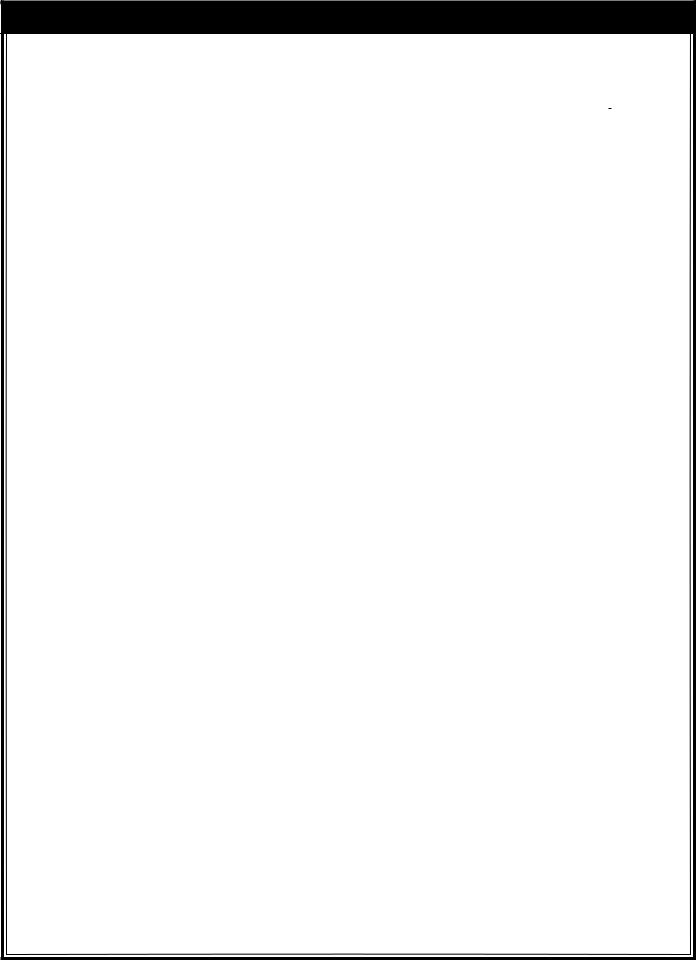
INSTALLATION REQUIREMENTS FOR THE COMMONWEALTH OF MASSACHUSETTS
For all side wall terminated, horizontally vented power vent, direct vent, and power direct vent gas fueled water heaters installed in every dwelling, building or structure used in whole or in part for residential purposes, including those owned or operated by the Commonwealth and where the side wall exhaust vent termination is less than seven (7) feet above finished grade in the area of the venting, including but not limited to decks and porches, the following requirements shall be satisfied:
INSTALLATION OF CARBON MONOXIDE DETECTORS At the time of installation of the side wall horizontal vented gas fueled equipment, the installing plumber or gasfitter shall observe that a hard wired carbon monoxide detector with an alarm and battery back-up is installed on the floor level where the gas equipment is to be installed. In addition, the installing plumber or gasfitter shall observe that a battery operated or hard wired carbon monoxide detector with an alarm is installed on each additional level of the dwelling, building or structure served by the sidewall horizontal vented gas fueled equipment. It shall be the responsibility of the property owner to secure the services of qualified licensed professionals for the installation of hard wired carbon monoxide detectors.
In the event that the side wall horizontally vented gas fueled equipment is installed in a crawl space or an attic, the hard wired carbon monoxide detector with alarm and battery back-up may be installed on the next adjacent floor level.
In the event that the requirements of this subdivision can not be met at the time of completion of installation, the owner shall have a period of thirty (30) days to comply with the above requirements provided that during said thirty (30) day period, a battery operated carbon monoxide detector with an alarm shall be installed.
APPROVED CARBON MONOXIDE DETECTORS Each carbon monoxide detector as required in accordance with the above provisions shall comply with NFPA 720 and be ANSI/UL 2034 listed and CSA certified.
SIGNAGE A metal or plastic identification plate shall be permanently mounted to the exterior of the building at a minimum height of eight (8) feet above grade directly in line with the exhaust vent terminal for the horizontally vented gas fueled heating appliance or equipment. The sign shall read, in print size no less than one-half (1/2) inch in size, “GAS VENT DIRECTLY BELOW.
KEEP CLEAR OF ALL OBSTRUCTIONS.”
INSPECTION The state or local gas inspector of the side wall horizontally vented gas fueled equipment shall not approve the installation unless, upon inspection, the inspector observes carbon monoxide detectors and signage installed in accordance with the provisions of 248 CMR 5.08(2)(a) 1 through 4.
EXEMPTIONS: The following equipment is exempt from 248 CMR 5.08(2)(a)1 through 4:
1.The equipment listed in Chapter 10 entitled “Equipment Not Required To Be Vented” in the most current edition of NFPA 54 as adopted by the Board; and
2.Product Approved side wall horizontally vented gas fueled equipment installed in a room or structure separate from the dwelling, building, or structure used in whole or in part for residential purposes.
MANUFACTURER REQUIREMENTS - GAS EQUIPMENT VENTING SYSTEM PROVIDED When the manufacturer of Product Approved side wall horizontally vented gas equipment provides a venting system design or venting system components with the equipment, the instructions provided by the manufacturer for installation of the equipment and the venting system shall include:
1.Detailed instructions for the installation of the venting system design or the venting system components; and
2.A complete parts list for the venting system design or venting system.
MANUFACTURER REQUIREMENTS - GAS EQUIPMENT VENTING SYSTEM NOT PROVIDED When the manufacturer of a Product Approved side wall horizontally vented gas fueled equipment does not provide the parts for venting the flue gases, but identifies “special venting systems,” the following requirements shall be satisfied by the manufacturer:
1.The referenced “special venting system” instructions shall be included with the appliance or equipment installation instructions; and
2.The “special venting systems” shall be Product Approved by the Board, and the instructions for that system shall include a parts list and detailed installation instructions.
A copy of all installation instructions for all Product Approved side wall horizontally vented gas fueled equipment, all venting instructions, all parts lists for venting instructions, and/or all venting design instructions shall remain with the appliance or equipment at the completion of the installation.
5
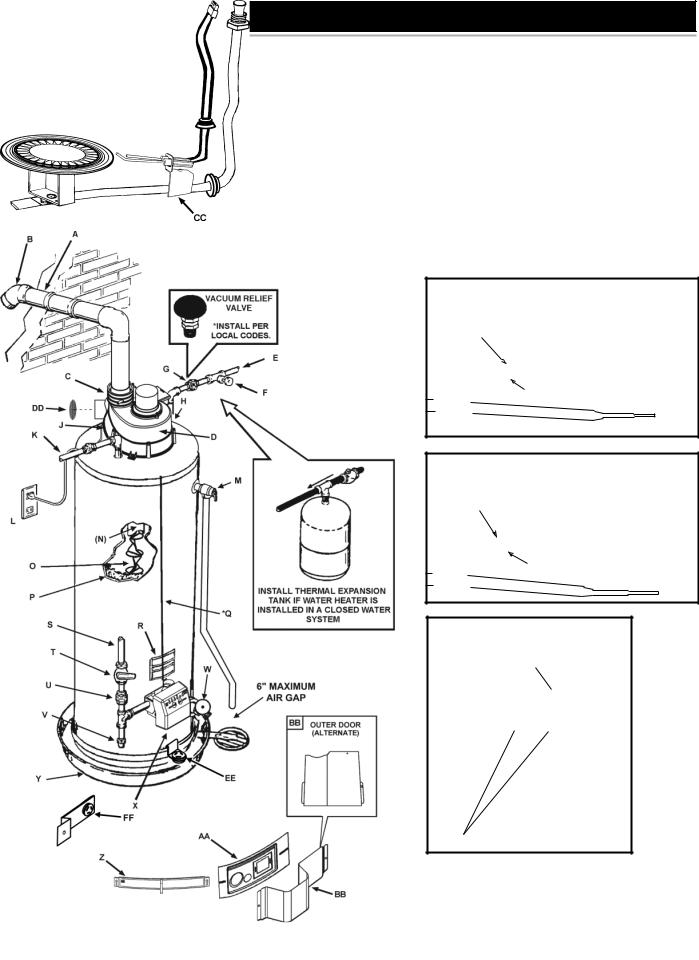
TYPICAL INSTALLATION
GET TO KNOW YOUR WATER HEATER - GAS MODELS
A |
Vent Pipe–Exhaust |
N |
Flue |
Z |
Air Intake Screen - Base Pan |
B |
Vent Terminal |
O |
Flue Baffle Assembly** |
AA |
Inner Door |
C |
Vent Adapter-Rubber Boot |
P |
Insulation |
B B |
Outer Door |
D |
Blower Assembly |
Q |
Control Harness |
CC |
HSI Burner Assembly |
E |
Cold Water Inlet |
R |
Rating Plate |
D D |
Air Intake Screen - |
F |
Inlet Water Shut-off Valve |
S |
Gas Supply |
|
Blower Assembly |
G |
Union |
T |
Manual Gas Shut-off Valve |
E E |
FV Sensor/Bracket Assembly |
H |
Inlet Dip Tube |
U |
Ground Joint Union |
|
(40K & 50K Models Only) |
J |
Anode** |
V |
Drip Leg (Sediment Trap) |
F F |
FV Sensor/Bracket Assembly |
K |
Hot Water Outlet |
W |
Drain Valve |
|
(55K & 62.5K Models Only) |
L |
Outlet Receptacle (115 VAC) |
X |
Gas Control Valve |
|
|
M |
Temperature-Pressure Relief Valve |
Y |
Drain Pan |
|
|
*ALL PIPING MATERIALS TO BE SUPPLIED BY CUSTOMERS.
**LOCATED UNDER THE BLOWER ASSEMBLY.
*CAUTION: 115 VAC IN CONTROL HARNESS AND INSIDE OUTER DOOR
GAS MODELS |
|
WITH HOT SURFACE IGNITION |
|
& 2", 3" OR 4" PVC VENT CAPABILITY |
FIGURE 1. |
NATURAL HOT SURFACE IGNITER & MAIN BURNER
HOT
SURFACE
IGNITOR
SENSOR
PROPANE HOT SURFACE IGNITER & MAIN BURNER
HOT
SURFACE
IGNITOR
SENSOR
GAS CONTROL VALVE-THERMOSTAT
TEMPERATURE INDICATORS
TEMPERATURE ADJUSTMENT BUTTONS
6
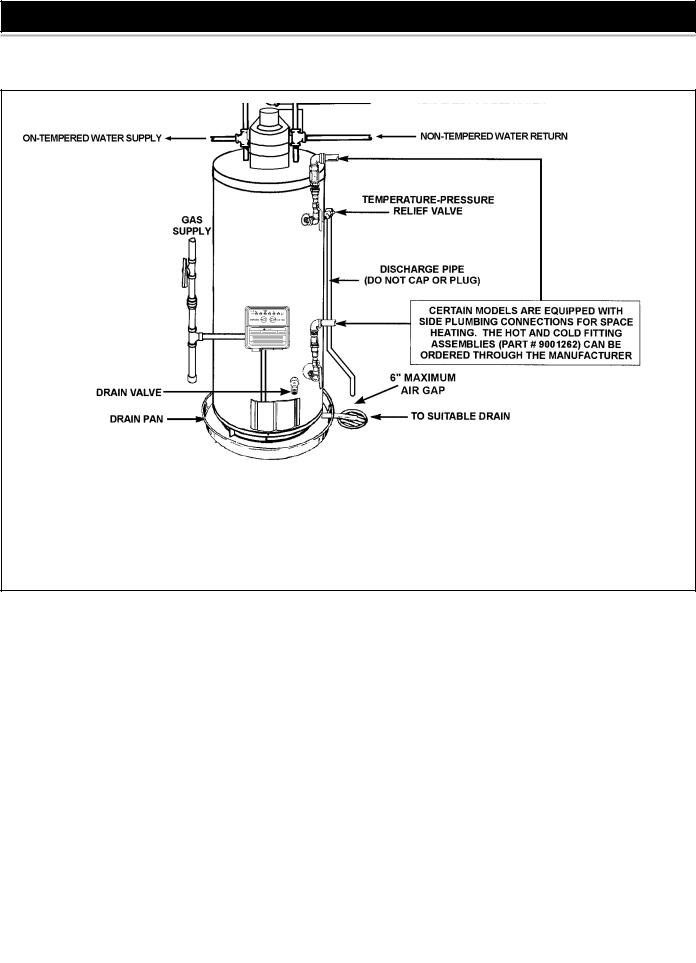
TYPICAL INSTALLATION
MIXING VALVE USAGE
FIGURE 2.
This appliance has been design certified as complying with American National Standard/CSA Standard for water heaters and is considered suitable for:
Water (Potable) Heating and Space Heating: All models are considered suitable for water (potable) heating and space heating.
HOTTER WATER CAN SCALD:
Water heaters are intended to produce hot water. Water heated to a temperature which will satisfy space heating, clothes washing, dish washing, and other sanitizing needs can scald and permanently injure you upon contact. Some people are more likely to be permanently injured by hot water than others. These include the elderly, children, the infirm, or physically/mentally handicapped. If anyone using hot water in your home fits into one of these groups or if there is a local code or state law requiring a certain temperature water at the hot water tap, then you must take special precautions. In addition to using the lowest possible temperature setting that satisfies your hot water needs, a means such as a *Mixing Valve, should be used at the hot water taps used by these people or at the water heater. Mixing valves are available at plumbing supply or hardware stores. Consult a Qualified Installer or Service Agency. Follow mixing valve manufacturer’s instructions for installation of the valves. Before changing the factory setting on the thermostat, read the “Temperature Regulation” section in this manual, see Figure 19.
7

LOCATING THE NEW WATER HEATER
FACTS TO CONSIDER ABOUT THE LOCATION
Carefully choose an indoor location for the new water heater, because the placement is a very important consideration for the safety of the occupants in the building and for the most economical use of the appliance. This water heater is not for use in manufactured
(mobile) homes or outdoor installation.
Whether replacing an old water heater or putting the water heater in a new location, the following critical points must be observed:
1.Select a location indoors as close as practical to the vent terminal or location to which the water heater vent piping is going to be connected, and as centralized with the water piping system as possible.
2.Selected location must provide adequate clearances for servicing and proper operation of the water heater.
Installation of the water heater must be accomplished in such a manner that if the tank or any connections should leak, the flow will not cause damage to the structure. For this reason, it is not advisable to install the water heater in an attic or upper floor. When such locations cannot be avoided, a suitable drain pan should be installed under the water heater. Drain pans are available at your local hardware store. Such a drain pan must have a minimum length and width of at least 2" (5.1 cm) greater that the water heater dimensions and must be piped to an adequate drain. The pan must not restrict combustion air flow.
Water heater life depends upon water quality, water pressure and the environment in which the water heater is installed. Water heaters are sometimes installed in locations where leakage may result in property damage, even with the use of a drain pan piped to a drain. However, unanticipated damage can be reduced or prevented by a leak detector or water shut-off device used in conjunction with a piped drain pan. These devices are available from some plumbing supply wholesalers and retailers, and detect and react to leakage in various ways:
•Sensors mounted in the drain pan that trigger an alarm or turn off the incoming water to the water heater when leakage is detected.
•Sensors mounted in the drain pan that turn off the water supply to the entire home when water is detected in the drain pan.
•Water supply shut-off devices that activate based on the water pressure differential between the cold water and hot water pipes connected to the water heater.
•Devices that will turn off the gas supply to a gas water heater while at the same time shutting off its water supply.
INSTALLATIONS IN AREAS WHERE FLAMMABLE LIQUIDS (VAPORS) ARE LIKELY TO BE PRESENT OR STORED (GARAGES, STORAGE AND UTILITY AREAS, ETC.): Flammable liquids (such as gasoline, solvents, propane (LP or butane, etc.) and other substances (such as adhesives, etc.) emit flammable vapors which can be ignited by a gas water heater’s hot surface igniter or main burner. The resulting flashback and fire can cause death or serious burns to anyone in the area. This water is equipped with a FV sensor for detecting the presence of flammable vapors, see Figure 3. When the sensor detects those vapors, the unit will shut down and not operate. Should this happen, please refer to the troubleshooting guide on pages 28-30. Even though this water heater is a flammable vapors ignition resistant water heater and is designed to reduce the chances of flammable vapors being ignited, gasoline and other flammable substances should never be stored or used in the same vicinity or area containing a gas
water heater or other open flame or spark producing appliance.
8
FIGURE 3.
Also, the water heater must be located and/or protected so it is not subject to physical damage by a moving vehicle.
This water heater must not be installed directly on carpeting. Carpeting must be protected by metal or wood panel beneath the appliance extending beyond the full width and depth of the appliance by at least 3" (7.6 cm) in any direction, or if the appliance is installed in an alcove or closet, the entire floor must be covered by the panel. Failure to heed this warning may result in a fire hazard.
Minimum clearances between the water heater and combustible construction are 0 inch at the sides and rear, 5" (12.7 cm) from the front
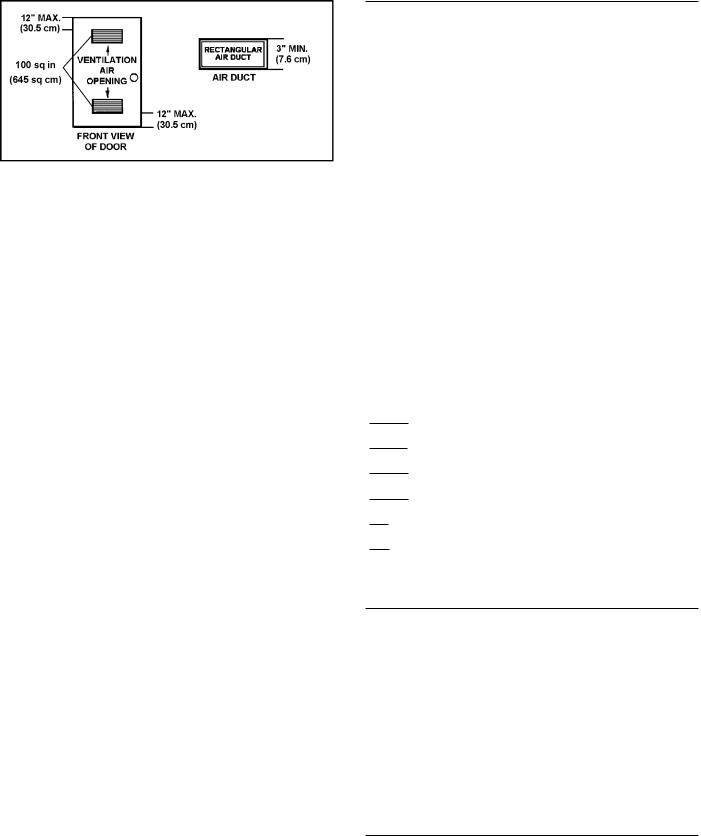
and 12" (30.5 cm) from the top. (Standard clearance.) If clearances stated on the heater differ from standard clearances, install water heater according to clearances stated on the heater.
Adequate clearance for servicing this appliance should be considered before installation, such as changing the anodes, etc.
A minimum clearance of 5" (12.7 cm) must be allowed for access to replaceable parts such as the thermostats, drain valve and relief valve.
When installing the heater, consideration must be given to proper location. Location selected should be as close to the wall as practicable and as centralized with the water piping system as possible.
FIGURE 4.
A gas water heater cannot operate properly without the correct amount of air for combustion. Do not install in a confined area such as a closet, unless you provide air as shown in the “Locating The New Water Heater” section. Never obstruct the flow of ventilation air. If you have any doubts or questions at all, call your gas supplier. Failure to provide the proper amount of combustion air can result in a fire or explosion and cause death, serious bodily injury, or property damage.
FIGURE 5.
If this water heater will be used in beauty shops, barber shops, cleaning establishments, or self-service laundries with dry cleaning equipment, it is imperative that the water heater or water heaters be installed so that combustion and ventilation air be taken from outside these areas.
Propellants of aerosol sprays and volatile compounds, (cleaners,
chlorine based chemicals, refrigerants, etc.) in addition to being highly flammable in many cases, will also react to form corrosive hydrochloric acid when exposed to the combustion products of the water heater. The results can be hazardous, and also cause product failure.
INSULATION BLANKETS
Insulation blankets are available to the general public for external use on gas water heaters but are not necessary with these products. The purpose of an insulation blanket is to reduce the standby heat loss encountered with storage tank heaters. Your water heater meets or exceeds the National Appliance Energy Conversation Act standards with respect to insulation and standby loss requirements, making an insulation blanket unnecessary.
Should you choose to apply an insulation blanket to this heater, you should follow these instructions (For identification of components mentioned below, see Figure 1). Failure to follow these instructions can restrict the air flow required for proper combustion, potentially resulting in fire, asphyxiation, serious personal injury or death.
•Do not apply insulation to the top of the water heater, as this will interfere with safe operation of the draft hood.
•Do not cover the outer door, thermostat or temperature & pressure relief valve.
•Do not allow insulation to come within 2" (5.1 cm) of the floor to prevent blockage of combustion air flow to the burner.
•Do not cover the instruction manual. Keep it on the side of the water heater or nearby for future reference.
•Do obtain new warning and instruction labels from the manufacturer for placement on the blanket directly over the existing labels.
•Do inspect the insulation blanket frequently to make certain it does not sag, thereby obstructing combustion air flow.
COMBUSTION AIR AND VENTILATION FOR APPLIANCES LOCATED IN UNCONFINED SPACES
UNCONFINED SPACE is space whose volume is not less than 50 cubic feet per 1,000 Btu per hour (4.8 cubic meters per kW) of the aggregate input rating of all appliances installed in that space. Rooms communicating directly with the space in which the appliances are installed, through openings not furnished with doors, are considered a part of the unconfined space.
In unconfined spaces in buildings, infiltration may be adequate to provide air for combustion, ventilation and dilution of flue gases. However, in buildings of tight construction (for example, weather stripping, heavily insulated, caulked, vapor barrier, etc.), additional air may need to be provided using the methods described in “Combustion Air and Ventilation for Appliances Located in Confined Spaces.”
COMBUSTION AIR AND VENTILATION FOR APPLIANCES LOCATED IN CONFINED SPACES
CONFINED SPACE is a space whose volume is less than 50 cubic feet per 1,000 Btu per hour (4.8 cm per kW) of the aggregate input rating of all appliances installed in that space.
9

Chemical vapor corrosion of the flue, blower assembly and vent system may occur if air for combustion contains certain chemical vapors. Spray can propellants, cleaning solvents, refrigerator and air conditioner refrigerants, swimming pool chemicals, calcium and sodium chloride, waxes, bleach and process chemicals are typical compounds which are potentially corrosive.
A. ALL AIR FROM INSIDE BUILDINGS: (See Figure 5 and 6) |
|
The confined space shall be provided with two permanent openings |
|
communicating directly with an additional room(s) of sufficient volume |
|
so that the combined volume of all spaces meets the criteria for an |
|
unconfined space. The total input of all gas utilization equipment |
|
installed in the combined space shall be considered in making this |
|
determination. Each opening shall have a minimum free area of one |
|
square inch per 1,000 Btu per hour (22 cm2/kW) of the total input rating of |
|
all gas utilization equipment in the confined space, but not less than 100 |
FIGURE 8. |
square inches (645 cm2). One opening shall commence within 12 inches |
|
(31 cm) of the top and one commencing within 12 inches (31 cm) of |
4. When ducts are used, they shall be of the same cross-sectional |
the bottom of the enclosures. |
area as the free area of the openings to which they connect. The |
|
minimum short side dimension of rectangular air ducts shall not |
|
be less than 3 inches (7.6 cm), see Figure 9. |
FIGURE 6. |
FIGURE 9. |
|
|
B. ALL AIR FROM OUTDOORS: (See Figures 7, 8 and 9) |
5. Alternatively a single permanent opening may be used when |
|
communicating directly with the outdoors, or with spaces that freely |
The confined space shall be provided with two permanent openings, |
communicate with the outdoors. The opening shall have a minimum |
one commencing within 12 inches (31 cm) of the top and one |
free area of 1 square inch per 3,000 BTU per hour (8.3 cm2/kW) |
commencing within 12 inches (31 cm) from the bottom of the |
of total input rating of all equipment in enclosure. See Figure 9A. |
enclosure. The openings shall communicate directly, or by ducts, |
|
with the outdoors or spaces (crawl or attic) that freely communicate |
|
with the outdoors. |
|
1. When directly communicating with the outdoors, each opening shall |
|
have a minimum free area of 1 square inch per 4,000 Btu per hour |
|
(5.5 cm2/kW) of total input rating of all equipment in the enclosure, |
|
see Figure 7. |
|
|
|
FIGURE 9A. |
|
|
6. Louvers and Grilles: In calculating free area, consideration shall be |
|
|
given to the blocking effect of louvers, grilles or screens protecting |
|
|
openings. Screens used shall not be smaller than 1/4 inch |
|
|
(6.4 mm) mesh. If the free area through a design of louver or |
FIGURE 7. |
|
grille is known, it should be used in calculating the size opening |
|
required to provide the free area specified. If the design and free |
|
2. When communicating with the outdoors through vertical ducts, each |
|
area is not known, it may be assumed that wood louvers will be |
|
20-25 percent free area and metal louvers and grilles will have |
|
opening shall have a minimum free area of 1 square inch per 4,000 |
|
60-75 percent free area. Louvers and grilles shall be fixed in the |
Btu per hour (5.5 cm2/kW) of total input rating of all equipment in |
|
open position or interlocked with the equipment so that they are |
the enclosure, see Figure 8. |
|
opened automatically during equipment operation. |
3. When communicating with the outdoors through horizontal ducts, |
|
7. Special Conditions Created by Mechanical Exhausting or Fireplaces: |
each opening shall have a minimum free area of 1 square inch |
|
operation of exhaust fans, ventilation systems, clothes dryers or |
per 2,000 Btu per hour (11 cm2/kW)) of total input rating of all |
|
fireplaces may create conditions requiring special attention to avoid |
equipment in the enclosure, see Figure 9. |
10 |
unsatisfactory operation of installed gas utilization equipment. |
|
|
